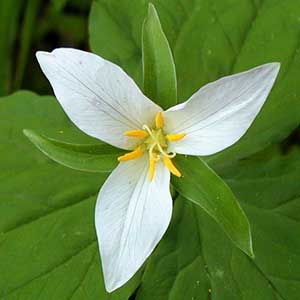Trillium ovatum
Trillium chloropetalum
Pacific trillium, trillium, western trillium, western wake-robin, western white trillium, white or western trillium, white trillium
giant purple wakerobin, giant trillium, giant wakerobin, sessile trillium, small-flower trillium
semierect to horizontal, short, stout, praemorse.
± erect, brownish, somewhat compressed-thickened, superficially bulblike, praemorse, not brittle.
1–2, round, 2–5 dm, ± slender, glabrous.
1–3, green, round in cross section, 2–6.5 dm, robust.
sessile, subsessile, or short-petiolate;
blade medium green, sometimes blotched and mottled, main veins prominent, ovate-rhombic, 7–12 × 5–20 cm, continuing to expand during anthesis, base rounded, apex acuminate.
held well above ground, sessile (narrowing of bract blade may give bract subsessile appearance);
blade densely to weakly mottled in dark brownish green, mottling becoming more obscure to absent as bract matures, broadly ovate, 7–17.6 × 7.4–17.7 cm, not glossy, apex obtuse-rounded.
erect or nodding, odorless;
sepals spreading to horizontal, green, lanceolate to oblong-lanceolate, 15–50 × 6–20 mm, margins entire, apex acute;
petals erect-ascending, usually wide-spreading from base, exposing entire pistil, white or with pink or blush markings, lacking V-shaped markings, fading to rosy pink, purple, or dark red, veins not deeply engraved, ± linear to widely obovate, 1.5–7 ×1–4 cm, widest at or above middle, thin-textured, margins flat to undulate, apex acuminate;
stamens prominent, slightly recurved-spreading to straight, 10–18 mm;
filaments white, shorter than anthers, slender;
anthers yellow, 4–16 mm, slender, dehiscence latrorse-introrse;
ovary green or white, ovoid, 6-angled, 5–12 mm, attachment ± 3/4 ovary width;
stigmas recurved, barely connate basally, greenish white or white, linear, not lobed adaxially, 6–10 mm, uniformly thin;
pedicel erect to leaning, 2–6 cm.
erect, odor roselike, spicy;
sepals spreading-ascending above bracts, green, lanceolate, 35–65 × 7–12 mm, margins entire, flat, apex obtusely rounded;
petals long-lasting, erect, connivent, ± concealing stamens and ovary, yellow, bronze, maroon, brown, deep purple, reddish brown, pink, dark purplish red, purplish bronze, rarely greenish white, not spirally twisted, veins not engraved, oblanceolate to obovate, 6.5–10 × 1.5–2.5 cm, thick-textured, base cuneate, margins entire, apex variably acute to almost truncate, erose;
stamens erect, purplish, 17–26 mm;
filaments purple, ca. 4 mm, widest at base, much shorter than anther sacs;
anthers erect, straight, ± purple-brown, 13–22 mm, dehiscence introrse;
connectives purple, straight, extended ca. 1–1.5 mm beyond anther sacs;
ovary purple, ovoid, 6-angled, 6–12 mm;
stigmas small, divergent or erect, distinct, purple, subulate, 4–8 mm, not fleshy.
baccate, green or white, ± odorless, broadly ovoid, obscurely winged, 1.2–2.8 × 0.7–1.9 cm, pulpy-moist.
red-purple, fragrance not reported, ovoid, obscurely 6-angled, 2.5–3 cm, pulpy, juicy.
= 10.
= 10.
Trillium ovatum
Trillium chloropetalum
Varieties 2 (2 in the flora).
(Discussion copyrighted by Flora of North America; reprinted with permission.)
Varieties 2 (2 in the flora).
J. D. Freeman (1975) considered that Trillium chloropetalum differs from T. albidum in having introrse (not latrorse) anther sacs, and that the purple pigments present on anther and ovary tissue here are absent in T. albidum. In some places, hybridization between the two certainly has occurred, and a complete range of intergrades exists.
This species merits further study. The following varieties are only weakly differentiated and perhaps ought to be dropped.
(Discussion copyrighted by Flora of North America; reprinted with permission.)
1. Bracts sessile; petals lanceolate to obovate, 1.5–7 × 1–4 cm | var. ovatum |
1. Bracts distinctly short-petiolate; petals linear to linear-lanceolate, 0.5–2.4 × 0.2–0.6 cm | var. oettingeri |
1. Petal tissue always with yellow pigments, often present with other pigments; petals yellow, greenish yellow, greenish purple, or bronze-green or brown. | var. chloropetalum |
1. Petal tissue lacking yellow pigments; petals purple, reddish purple, garnet red, pink, or greenish white. | var. giganteum |
- Local floras:
BC,
CA,
OR,
WA
- Local Web sites:
CalFlora,
CalPhotos,
Flora NW,
PNW Herbaria,
Turner Photog.
WildflowerSearch
iNaturalist (observations)
USDA Plants Database
- LBJ Wildflower Center
- SEINet
- Plants of the World Online
- Encyclopedia of Life
- Wikipedia
- Google Image Search


